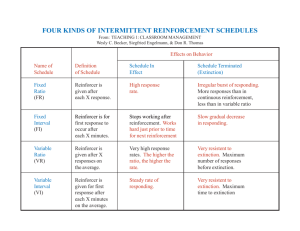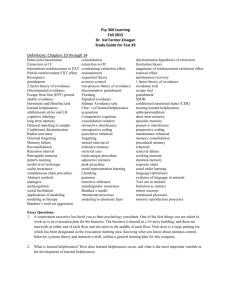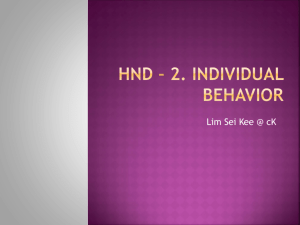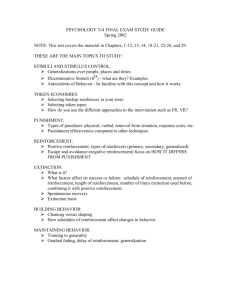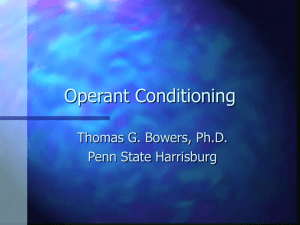Extinction
advertisement
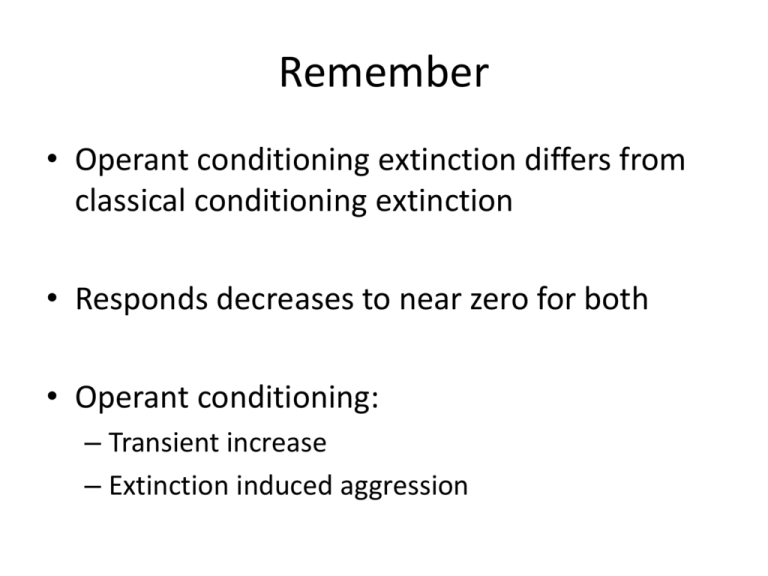
Remember • Operant conditioning extinction differs from classical conditioning extinction • Responds decreases to near zero for both • Operant conditioning: – Transient increase – Extinction induced aggression Partial Reinforcement Extinction Effect: PREE • Extinction occurs at different rates depending on the schedule: – Continuous reinforcement: FAST extinction – Partial reinforcement schedules: SLOWER extinction – Variable schedules show slower extinction than fixed (rate or time) schedules. • PREE used to describe greater persistence in instrumental responding during extinction after partial (or intermittent) reinforcement training – Faster extinction after continuous reinforcement training. • Partial reinforcement schedules show RESISTANCE TO EXTINCTION Other Extinction Effects • Magnitude reinforcement extinction effect – Less persistence of instrumental behavior in extinction following training with a large reinforcer – More persistance of responding with a small or moderate reinforcer. – Effect is most prominent with continuous reinforcement. • Overtraining extinction effect – Less persistence of instrumental behavior in extinction following extensive training with reinforcement (overtraining) – Faster extinction following moderate levels of reinforcement training. – Again, effect most prominent with continuous reinforcement Other Extinction Effects • Reinstatement – Recovery of responding to an extinguished stimulus – produced by exposures to unconditioned stimulus or reinforcer • Renewal – Recovery of excitatory responding to an extinguished stimulus – produced by shift away from the contextual cues that were present during extinction. Discrimination and Frustration • Discrimination hypothesis: – Mowrer and Jones 1945 – In order for subjects’ behavior to change during extinction, the subject must be able to discriminate the change in reinforcement contingencies • With CRF: This is immediately noticeable • With PRF: not immediately noticeable – More discriminative on fixed schedules – Less discriminative on variable schedules • Evidence does not completely support this Generalization Decrement Hypothesis • Capaldi, 1966 • Generalization decrement: decreased responding observed in generalization test when test stimuli become less and less similar to training stimulus • Responding during extinction is weak if the stimuli present during extinction are different from those during the reinforcement phase • Responding during extinction is STRONG if the stimuli present during extinction are very similar to those during reinforcement phase. Generalization Decrement Hypothesis • Large generalization decrement when schedule moves from CRF to EXT – Large noticeable change between CRF and EXT – During CRF: Subject never experienced situation in which some of its responses are not reinforced – Not been taught to keep responding in absence of a reinforcer • Smaller generalization decrement when schedule moves from PRF to EXT – Very small change between PRF and EXT – Subject has experience in situation where some of its responses are not reinforced – HAS been taught to keep responding in absence of a reinforcer Sequential Theory • Sequential theory: memory of reward vs. non reward – Cognitive theory • Fast extinction after CRF – Extinction occurs quickly because the instrumental response has NOT been conditioned to the memory of nonreward • Slow extinction during PREE – extinction is slowed after partial reinforcement because the instrumental response becomes conditioned to the memory of nonreward. Behavioral Momentum theory • A metaphor based an analogy between physical momentum and the tendency for behavior to persist even when conditions change • Refers to the tendency for a pattern of behavior, once established, to persist despite some opposition to the response-reinforcer relationship – Physical momentum is the tendency for an object in motion to continue at the same velocity unless opposed by a physical force. – Momentum = mass x velocity • In the behavioral momentum metaphor, behavioral momentum is the product of behavioral mass and behavioral velocity – Behavioral velocity is equal to (baseline) response rate – Behavioral mass is the resistance of the baseline response rate to change when the response-reinforcer relationship is disrupted Behavioral Momentum theory • Assumes that there are two separable aspects of the discriminated operant that independently govern – the rate at which a response occurs – the persistence of that response in the face of operant disruption – (Nevin & Grace, 2000). • Disruptions may include – – – – – Punishment Extinction Differential reinforcement of alternative behaviors Distractions Pre-feeding or providing extra food between the components of a multiple schedule Behavioral Momentum Behavioral Momentum • Behavioral momentum is directly related to the rate of reinforcement: • Higher rates of reinforcement produce behavior that has greater momentum and is less susceptible to disruption • Behavioral momentum is unrelated to the actual response rate – 2 behaviors may occur at the same rate – But may have different controlling variables, and thus differ in their behavioral momentum • Behavioral momentum can explain the PREE effect: – PREE occurs because the animal has a high momentum of responding during partial reinforcement than during continuous reinforcement and it is more difficult to stop this momentum Behavioral Momentum • With continuous reinforcement: – Make a responseaccess reinforcer. – Response momentum is a single response • With partial reinforcement: – Make many responsesaccess reinforcer. – Response momentum = many responses • Now: disruptor of EXT occurs: – Compare: 1 response1 reinforcer vs. #s responses no reinforcer – Compare: #s responsesreinforcer vs. #s responses no reinforcer • Which situation is it more noticeable! The High-P instructional sequence: A procedure for increasing compliance to Low-P instructions Mace, Hock, Lalli, West, Belfiore, Pinter & Brown (1988) • Rationale—use high rate reinforcement to establish a momentum of compliance that will be resistant to change when a low-p instruction is presented • General Procedure: – – – – Identify a set of 6-10 instructions yielding > 80% compliance Identify a set of 6-10 instructions yielding < 30% compliance Present 3-4 high-p instructions with an IPT of 5-10 sec Praise compliance to all instructions • Following compliance to 3 consecutive high-p instructions, deliver low-p instruction within 5 s • 1-min inter-trial interv Examples of Behavioral Momentum Results • Figures show the trial-by-trial frequency of compliance for – Low p instruction during baseline – High p treatment conditions (praise only) • Compliance was low during baseline but much higher for the high-p condition • Notice the effect of food and just praise Trial by trial cumulative frequency of compliance to low-p instructions under baseline, high-p treatment with praise (HwP), and high-p treatment with food HwF) conditions Trial by trial cumulative frequency of compliance to low-p instructions under baseline, high-p treatment with praise (HwP), and high-p treatment with food HwF) conditions Conclusions: • This experiment demonstrated the efficacy of the high-p treatment can be improved by reinforcing compliance to high-p with a presumably higher quality reinforcer than praise. • Support the hypothesis that behavioral momentum is functionally related to reinforcer quality. Avoidance: Is negative REINFORCEMENT! Avoidance Tests • Negative reinforcement = removing a stimulus to INCREASE a behavior • Negative reinforcement = – escape: a response removes something – avoidance: a response prevents some event • Procedure for studying negative reinforcement and avoidance: Discriminated avoidance: – a response CANCELS a shock – Organism is responding for food reinforcers – When light comes on, must press another lever to AVOID the shock • • • if the response does not occur during the S+ the stimulus is followed by a shock if the response does occur during the S+, the shock is cancelled – – thus: signal or sD for shock if this were an escape: response could also occur DURING the shock to shut off shock Negative Reinforcement in Humans • Most often "reinforcement" technique used in real world – Often used because is cheaper, easier, more natural – Produces "bad" side effects: avoidance responses to SD = boss, principal, spouse, etc. • Data show it is a highly ineffective reinforcement procedure with many side effects Characteristics of Avoidance Behavior • Negatively reinforced behavior is difficult to extinguish: – escape behaviors take long time to go away – e.g.: rat in 1-way shuttle still runs when light comes on-even after hundreds of EXT trials • BUT: will extinguish quickly if animal can detect change from conditioning to EXT situation Characteristics of Avoidance Behavior • Extremely variable: – from subject to subject – from session to session with SAME subject – procedure to procedure • Choice of response is important – determines how quickly will learn contingency – how well learning is maintained • Example: 1-way vs 2-way shuttle avoidance tests: – Rat learns to run to the safe side shuttle box when the light comes on to avoid shock – 1-way shuttle: run to other (always the same) area when light comes on – 2-way shuttle: run to opposite (changing) area when light comes on • Why do animals have a difficult time learning 2-way shuttle avoidance Characteristics of Avoidance Behavior • Species specific Defense reactions: SSDRs – Bob Bolles (1970, 1971) – behaviors which animal does naturally in time of danger – includes: freezing, fleeing, fighting • Why? – animal has innate behaviors does when avoiding noxious stimulus– can't make it go against its nature Avoidance behavior in Humans • Humans have many ineffective and/or irrational fears – Often involve avoidance responses due to original fear – Maintained by decrease in fear – e.g., banging two sticks to keep the tigers away • Symptoms of obsessive/compulsive disorders: – compulsions = repeated, stereotyped, ritualized actions • individual feels compelled to engage in them – obsessions = compulsive thoughts (no actual actions) – many, many examples of this – can begin to interfere in life Theories of Avoidance: Two Factor theory • Two things happen during avoidance conditioning: 1. animal learns to fear S+ via class. conditioning • CS (light)---> US (shock): UR (fear) • animal learns to fear light via pairing with shock 2. animal will then learn a response to AVOID shock and thus remove/lessen their fear – Thus: not getting shocked reduces fear that was signaled by the CS • Experimental evidence: – On initial training trials: light/CS produces physiological symptoms of fear • Escape response results in decrease in these physiological symptoms – On later trials: • little or no evidence of physiological fear with CS presentation • suggests fear has been reduced/replaced by the escape response – in sense: forms a negative feedback loop Problems with 2-factor theory: • Signs of fear dissipate w/time: – as animal gets "better" at avoidance response – thus: no fear to be avoided • The CS is not as important in avoidance learning as 2-factor theory states: – Animals can learn to avoid in a discriminated avoidance situation long before there is any sign that they are responding to/detecting the CS Two Avoidance Procedures: • Sidman Avoidance: – – – – – the response POSTPONES or DELAYS the shock thus: only temporary solution must keep responding to keep delaying the shock results in lots of responding again: some signal may be used to signal when must respond • Herrnstein and Hineline Procedure: – – – – the response reduces the rate of the shock note: note delay or cancel, just slows down rate of delivery the response switches the schedule of shock to a lower rate Note: cannot entirely AVOID shock in this procedure: • once animal receives shock on lowered schedule, reverts back to original schedule • animal must respond again to switch schedule again Herrnstein and Hineline: Test of 2-factor theory • Test of the theory: – two groups of rats used – Group 1: can turn off light, but still get shock – Group 2: can turn off shock, light still on • 2-factor theory would predict that Group 1 should respond more, because this would be cancelling the CS that produces fear • Results: group 2 responds much more accurately, faster Alternative: One-Factor Theory • Responses occur whenever they reduce the rate at which aversive events occur • When a CS is present: only providing information about the effectiveness of a response • Fear may be a by-product of avoidance training, but not crucial to learning/ maintaining an avoidance response Evidence for One-Factor theory • Almost postulating a "cognitive" theory of avoidance: • Seligman and Jonston (1973) did postulate cognitive theory: – like Rescorla Wagner theory in that deals with predictability • Basic premise: – Learning occurs only when there is a discrepancy between observation and expectation – Subjects' behavior will change in avoidance task whenever there is a discrepancy between expectancy and observation Evidence for One-Factor theory • Two important expectations in avoidance task: – Expectation about consequences of a response – Expectation about consequences of not responding • Data support One-factor theory – On trial 1: no expectations – On trial 2 (and more): expectation about what will happen • no shock will occur if response is made – Shock will occur if no response is made – Animal prefers no shock to shock- so responds • Contingency is what is important in avoidance, fear is by-product! Flooding as an aversive: • To extinguish an inappropriate response: must make contact with "changed reinforcement or punishment" situation • sometimes used as alternative to systematic desensitization • flood with presentation of fear-provoking stimulus – Again, no actual consequence occurs – Continue presentations until the response is extinguished • Problem: may "scare the patient to death" Evidence, con’t. • As long as animal continues to respond- no shock – Not know when extinction occurs- no sampling – only stop when learn situation has changed • Thus: to EXT responding: – – – – Must use response blocking or flooding: present sD, but prevent R from occurring thus animal learns that shock no longer comes animal stops responding in presence of sD Perceived Control and Avoidance • Significant side effects may be produced by avoidance tasks – Animal psychosis or experimental psychosis – Animal stops eating, drinking – Animal may engage in self injurious behavior • Appears to be due to implementation of an avoidance contingency under certain conditions Learned helplessness Marty Seligman • Four groups of dogs Grp Grp Grp Grp Training I and II I Escapable/escapeable II Inescapable/inescapable III Escapable/inescapable III Inescapable/escapable result Lasting effects run None not run None not run None not run Severe Remember, Seligman’s hypothesis was that NONE of the dogs would be significantly harmed. Key Factor = inescapability once learned not to escape (learned to be helpless)= not change Characteristics of L.H. • inescapability that produces phenomenon, not the shock itself • works under variety of procedures, conditions • very generalizeable, transferable • if take far enough, can make it a contingency rule for the animal, rather than specific contingency for specific situation(s) Symptoms of L.H. • • • • • passivity learned laziness retardation of learning somatic effects reduction of helplessness with time Clinical expressions of learned helplessness • School phobias and math anxiety • Abusive Relationships • Depression • Cultural learned helplessness “Curing” or eliminating learned helplessness • Unlearn the rule • Reshape or recondition • Must be done in situation where organism cannot fail • Difficult to do- animals can “not” respond • UPenn program on relearning thoughts during test taking Why? • Only when shock contingent on behavior do animals develop LH – Animals in no control/no control condition do not develop • Showed generalization very quickly – In situations where there WAS a contingency, the lack of behavior sabotaged results How is this an example of the importance of contingency? • Got themselves into contingency trap • If they don’t work, no reward, only punishment • This reinforced contingency rule that THEY were the cause of the bad consequences • Self sabotage • And it was true! • Thus: treatment must be to learn better contingencies and eliminate the bad (and in their head) contingency rule Why is this important for humans? • Helps explain the “misbehavior” of humans with some disorders • Drug addicts and those with schizophrenia make “poor” choices – May be due to physiology of the addiction or disease – “bad choices” may be due to effect of DA – Real changes may be occurring in the brain which prevent the addict from being sensitive to changes in his or her life rewards • May also explain some of the perseverative and off-task behaviors observed in these individuals What “causes” LH? • Newer research: original theory of learned helplessness NOT account for people's varying reactions to situations that can cause learned helplessness • Learned helplessness sometimes remains specific to one situation • At other times generalizes across situations • At first, difficult to predict which will occur in a given situation Attributional Style • attributional style/explanatory style: – key to understanding why people respond differently to adverse events – Refers to how individuals attribute cause to an outcome • group of people all experience same or similar negative event – BUT: each person person privately interprets cause of event – HOW one attributes causes to event will appears determine likelihood of LH Pessimistic explanatory style • sees negative events as – permanent : "it will never change“ – Personal: “it's all my fault“ – pervasive: "I can't do anything correctly“ • These individuals most likely to suffer from learned helplessness and depression Optimistic explanatory style • sees negative events as – Out of the ordinary: “tomorrow is a new day! “ – Impersonal: “it's NOT really my fault“ – Temporary: "I can do most things correctly“ • These individuals least likely to suffer from learned helplessness and depression Cognitive Behavior Therapy • Endorsed by Seligman, • Teaches people more realistic explanatory styles, • Shown to help ease depression. • Steven C. Hayes (U of Utah): recommends acceptance and commitment therapy to get rid of negative thoughts. Attribution Theory • Bernard Weiner (1979, 1985, 1986) • Examines how people attribute a cause or explanation to an unpleasant event. • Includes the dimensions of – globality/specificity: – stability/instability – internality/externality Global vs. specific Attributions • Specific attribution: individual believes cause of a negative event is unique to a particular situation. • Global Attribution: individual believes the cause of a negative event occurs across situations Stable vs. Unstable • Stable attribution: individual believes the cause to be consistent across time. • Unstable attribution: individual thinks that the cause is specific to one point in time. External vs. Internal • External attribution: assigns causality to situational or external factors • Internal attribution: assigns causality to factors within the person How develop positive thinking styles? • Innoculation programs • Teach to deal with failure! – Must experience failure to learn to frame it appropriately • Who is more likely to get depressed? • Straight A valedictorian receiving first C • B average student receiving first C • Why? • You aren’t learning if you don’t make “mistakes” – Mistakes are exploring the boundaries of a contingency! Conclusions • We are animals and we behave in ways that are consistent with other species. • There are biological boundaries or constraints in how we learn and react to our environment • Our biggest Human instinct: to learn, predict and control our environment • HOW we attribute causes influences the development of rules or heuristics for causation • Animal models allow us to investigate these boundaries and help explain human learning and choice behavior!
